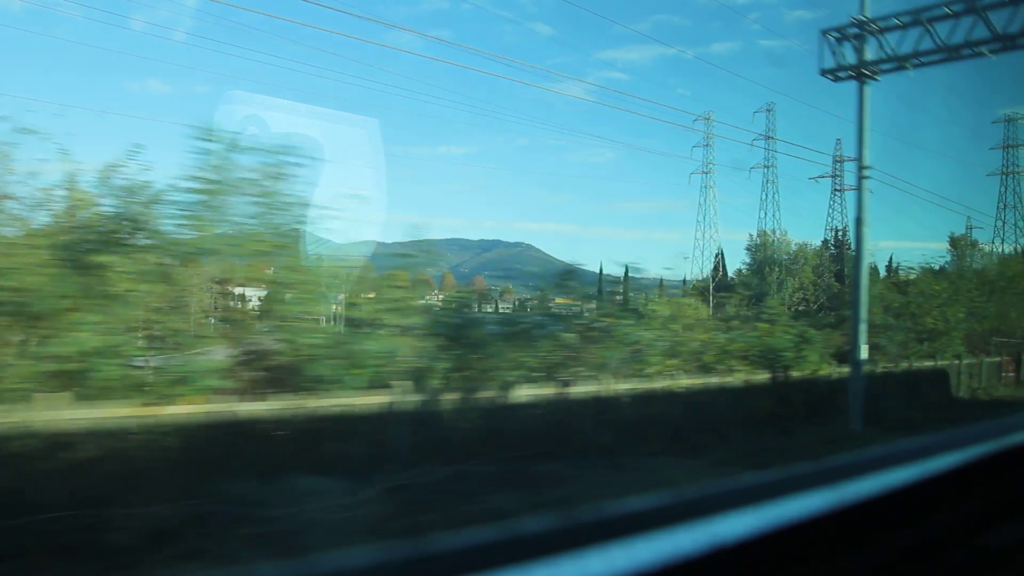The Corruption (1983)Enemy Is a Bowl of Soup: On Quino’s Mafalda
The Review’s Review

The cartoon character Mafalda, with her massive round head, sixties bob, triangular dress, and black Mary Janes, appears innocent. But this inquisitive girl-against-the-world is no ingenue—Mafalda often fires off sharp, incisive, and cynical observations about the political world around her. In Latin America, the comic strip named after her is legendary: although it ran for only nine years, from 1964 to 1973, this creation of the cartoonist Quino, the pen name of the illustrator Joaquín Salvador Lavado Tejón, captured how a society’s irony and humor survived one of Argentina’s darkest political chapters (a coup d’état initially led by Juan Carlos Onganía that took place between 1966 and 1970 and, later, Juan Domingo Perón’s third government, which oversaw the paramilitary anticommunist project that would set up the state for a dictatorship beginning in 1976).
This June, a collection of early Mafaldastrips will be published in English for the first time by Archipelago’s children’s book imprint, Elsewhere Editions, and its ideas still sound oddly current. In one famous image, published in 1965, Mafalda ponders her family’s globe. She then leaves, and returns to stick a sign on it that reads WARNING: IRRESPONSIBLE MEN AT WORK. When her mom asks her to dust off the globe, she wonders, “Do I clean all the countries, or just the ones that have dirty governments?” After a while, Mafalda realizes the globe might be sick. She covers it with bandages and brings it medicine. When her friend comes to visit, she asks for silence, out of respect for the convalescent. “Is your dad sick?” her friend asks, and she says no. “Your mom?” Neither of them. It’s the globe, she says, and brings her friend into her room, where Earth is resting peacefully. In later strips and in a similar spirit, Mafalda will debate the war in Vietnam and “play government” with her peers. “Don’t worry,” she exclaims when her mom walks in, “we have lots of policies, but we don’t actually do anything.” Her tiny body contrasts with her grandiloquent statements, both mocking the adult world around her and interpreting its political ideas with genuine concern.
Mafalda’s first run coincided with a period in Argentine history in which a series of military dictators—Juan Carlos Onganía, Roberto Marcelo Levingston, and Alejandro Agustín Lanusse—seized power and exercised both violent repression and brutal censorship of the press. Many of the topics that Mafaldatouches on were simply not allowed into the public sphere at the time. As a consequence, artists such as the musician and writer María Elena Walsh, the rock star Charly García, and illustrators like Quino shifted to making children’s art, which was less scrutinized. In Mafalda, Quino found an effective yet apparently inoffensive outlet for his critiques of society. When Mafalda encounters a policeman, for example, she asks him if he’s a good person and he responds, “Police officers are always good people.” Then she looks into the bag that holds his gun and walks away, declaring, “I think I’m starting to figure out how goodness works.” Years later, another classic cartoon would show her standing next to a tall cop with her younger brother and, pointing out his baton, and cynically telling him, “Do you see? This is the little stick they use to crush ideology.”
When I was growing up in Argentina in the early aughts, in the middle of yet another political crisis, Mafaldataught me how to think politically, even when I was too young for it. Children enjoy this—they appreciate it when you don’t underestimate their intelligence, and rise to the occasion as a result. For several generations after its original run,Mafaldawas published in sets of small, cheap strip books that you could buy at any newspaper stand or kiosk, making it affordable for parents and manageable for kids’ small hands.
But Mafalda was not the only memorable character in the strip. Quino created a group of neighborhood friends and classmates who inhabited different stereotypes of the time. The original gang includes Felipe, a neurotic, whimsical boy who loves the Lone Rangercomic books; Manolito, the son of Spanish immigrants, who works in his dad’s grocery store and is obsessed with money and success; and Susanita, who is proud of her bourgeois aspirations and is stereotypically feminine: she dreams of marrying a doctor, becoming a mother, and vacationing abroad. Later in the strip, toward the end of the sixties, Quino would add Mafalda’s sibling, Guille, who has the self-entitlement and irreverence that only a younger brother can have, and Libertad, the daughter of two left-wing activists, who advocates openly for Marxism and guerrilla warfare.
The cultural trends of the sixties and early seventies made their way into Mafalda through this same humorous effect, the kids’ tastes and mores imbued with a soixante-huitard sensibility. Mafalda is a fan of the Beatles, and she and Felipe get mad at Manolito when he insults their long hair, which at the time was a symbol of opposition to military conscription and to the buzz cuts men got while in service. During the space race, Mafalda similarly berates Manolito for not going to nursery school and declares, “Sending people into outer space is progress, not your papa’s grocery store!” Manolito responds, “But I’m also pretty interested in the cosmos! I’ve got plans for satellite stores.”
In many ways, the children in Mafaldaare mimicking the different worldviews they have inherited from their parents. Quino’s humor relies on placing adult sentences in children’s voices—an estrangement that has both an endearing and a satirical effect, and that allows him to mock and critique the middle-class values of traditional families, consumption, and conformism. Consider Mafalda’s depiction of gender roles: If a grown woman told us in a comic strip that she just wanted to get married and have children, this would sound old-school, boring, even passé. In a discussion between Susanita and Mafalda, however, it has a different angle. When Mafalda dreams that her mother went to university and got a degree (at a time when most women were mostly housewives) she describes this enthusiastically to Susanita, hoping to find a match in her excitement. Instead, Susanita asks if her mother got a “rich, handsome boyfriend” in Mafalda’s dream. Malfada says no. Susanita, the prototradwife, exclaims: “So she went to college and everything and she came away with NOTHING!”
One of the many ways political discourse makes its way into the comic is in Mafalda’s projections onto her archnemesis: a bowl of soup. Throughout the strip, the bowl of soup becomes a hated symbol of the seemingly healthy food that Mafalda is forced to consume—and, by extension, an emblem of what she’s been taught, the middle-class ideologies that suffuse her life. When Mafalda sees her mother clipping a fish soup recipe from a newspaper, she gets mad and imitates a dictator’s voice, shouting, “DOWN WITH FREEDOM OF THE PRESS!” On another day when she is served this soup, a single strip takes over the page, in which a distressed Mafalda announces, “Soup is to childhood what Communism is to democracy!” In soup, Mafalda sees an embodiment of the set of lies that adults are being fed—soup is the enemy, the man, and the hypocrisy of modern postwar life.
The culmination of Quino’s radical avoidance of censorship took place a day after Onganía’s 1966 coup d’état. On the day of the coup, the newspaper El Mundo, in which Mafaldaappeared at the time, was filled with neutral coverage: journalists couldn’t write openly against the regime change. Instead, the most revolutionary voice appeared in the children’s strip. In it, Mafalda seems anguished—this is not the same girl who had so self-assuredly argued against her father’s materialistic desire for a car and her mother’s preoccupation with beauty. Instead, she seems genuinely defeated, confused. In a single, close-up frame, she asks: “What happened with … Everything that we were taught at school …” She implies that the values of democracy, of being “a good person,” and of faith in the government are now deeply disrupted by Onganía’s violent seizure of power. And Quino, at the time, was one of the only writers who—in cryptic complicity with his readers—was able to say something about it.
By the early seventies, tensions in the political climate of Argentina had increased even more. Ediciones de la Flor, Quino’s publisher, became a target of censorship—one of its novels was even removed from print—and Quino stopped producing his comic books in 1973, alleging a “lack of new ideas.” In 1975, the Argentine Secretariat of Intelligence tried to appropriate Mafalda, and created its own apocryphal version of the cartoon, in which a poorly drawn Manolito incites young men to join the military service. A year after that, Quino’s editors were kidnapped by the military and eventually released under international pressure. Shortly thereafter, the military massacred five Pallottine priests with left-leaning ideas. The forensic photographs taken after the act produced a chilling image: the bodies of two of the priests sat lifeless next to a poster of a Mafalda cartoon the murders had ripped from the wall and placed next to the bodies. Here, the classic image is turned sinister: “Do you see?” Mafalda asks once more. “This is the little stick they use to crush ideology.”
Threatened by the political climate in an increasingly militarized country, Quino went into exile in 1976. Until 1973, Mafalda had continued to denounce the decaying values of her milieu, Argentina’s naive cultural dependence on the United States and Europe, the plethora of wars abroad, and the censorship of radical movements in Latin America. She did so in a witty and childlike way that was accessible to kids and parents alike; she was humorous but always sharp. After the return of democracy to the country in 1983, Quino not only went back to Buenos Aires and to his native province of Mendoza, but he also allowed Mafalda to be reproduced to promote the values of the new democratic regime. In many ways, the intergenerational battle that Mafaldarepresents still rings true, and is bound to educate nonconformist children in conformist times.
Julia Kornberg is the author ofBerlin Atomized.








